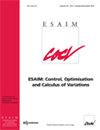一类具有周期输入的多面体扫描过程中非平凡有限时间稳定吸引子的形成
IF 1.2
3区 数学
Q4 AUTOMATION & CONTROL SYSTEMS
Esaim-Control Optimisation and Calculus of Variations
Pub Date : 2023-10-16
DOI:10.1051/cocv/2023074
引用次数: 0
摘要
我们考虑一种称为多面体扫描过程的微分包涵体。j - j介绍了一般的清扫过程。作为弹塑性体准静态变形的建模框架和多面体扫描过程通常用于弹塑性弹簧网络中的应力建模。Krejčí的定理指出,具有周期输入的扫掠过程有一个由周期解组成的全局吸引子,并且所有这样的周期解遵循相同的轨迹直至平行平移。我们证明了在具有周期输入的多面体扫描过程中,吸引子必须是一个固定形状的凸多面体X。我们提供的例子弹塑性弹簧模型导致结构稳定的情况下,X是一个一维或二维多面体。一般来说,多面体扫描过程的吸引子可能是指数稳定的,也可能是有限时间稳定的,本文的主要结果包括吸引子有限时间稳定的充分条件和沉降时间的上估计。这些结果对敲诈理论有启示意义。本文章由计算机程序翻译,如有差异,请以英文原文为准。
Formation of a nontrivial finite-time stable attractor in a class of polyhedral sweeping processes with periodic input
We consider a differential inclusion known as a polyhedral sweeping process. The general sweeping process was introduced by J.-J. Moreau as a modeling framework for quasistatic deformations of elastoplastic bodies, and a polyhedral sweeping process is typically used to model stresses in a network of elastoplastic springs. Krejčí’s theorem states that a sweeping process with periodic input has a global attractor which consists of periodic solutions, and all such periodic solutions follow the same trajectory up to a parallel translation. We show that in the case of polyhedral sweeping process with periodic input the attractor has to be a convex polyhedron X of a fixed shape. We provide examples of elasto-plastic spring models leading to structurally stable situations where X is a one or two- dimensional polyhedron. In general, an attractor of a polyhedral sweeping process may be either exponentially stable or finite-time stable and the main result of the paper consists of sufficient conditions for finite-time stability of the attractor, with upper estimates for the settling time. The results have implications for the shakedown theory.
求助全文
通过发布文献求助,成功后即可免费获取论文全文。
去求助
来源期刊

Esaim-Control Optimisation and Calculus of Variations
Mathematics-Computational Mathematics
自引率
7.10%
发文量
77
期刊介绍:
ESAIM: COCV strives to publish rapidly and efficiently papers and surveys in the areas of Control, Optimisation and Calculus of Variations.
Articles may be theoretical, computational, or both, and they will cover contemporary subjects with impact in forefront technology, biosciences, materials science, computer vision, continuum physics, decision sciences and other allied disciplines.
Targeted topics include:
in control: modeling, controllability, optimal control, stabilization, control design, hybrid control, robustness analysis, numerical and computational methods for control, stochastic or deterministic, continuous or discrete control systems, finite-dimensional or infinite-dimensional control systems, geometric control, quantum control, game theory;
in optimisation: mathematical programming, large scale systems, stochastic optimisation, combinatorial optimisation, shape optimisation, convex or nonsmooth optimisation, inverse problems, interior point methods, duality methods, numerical methods, convergence and complexity, global optimisation, optimisation and dynamical systems, optimal transport, machine learning, image or signal analysis;
in calculus of variations: variational methods for differential equations and Hamiltonian systems, variational inequalities; semicontinuity and convergence, existence and regularity of minimizers and critical points of functionals, relaxation; geometric problems and the use and development of geometric measure theory tools; problems involving randomness; viscosity solutions; numerical methods; homogenization, multiscale and singular perturbation problems.
 求助内容:
求助内容: 应助结果提醒方式:
应助结果提醒方式:


